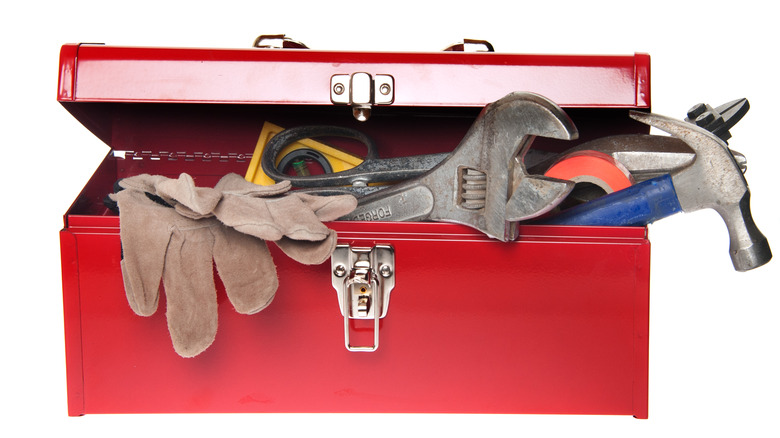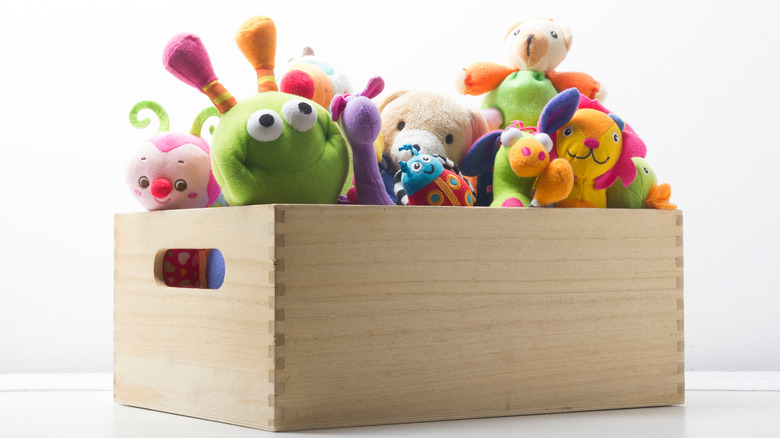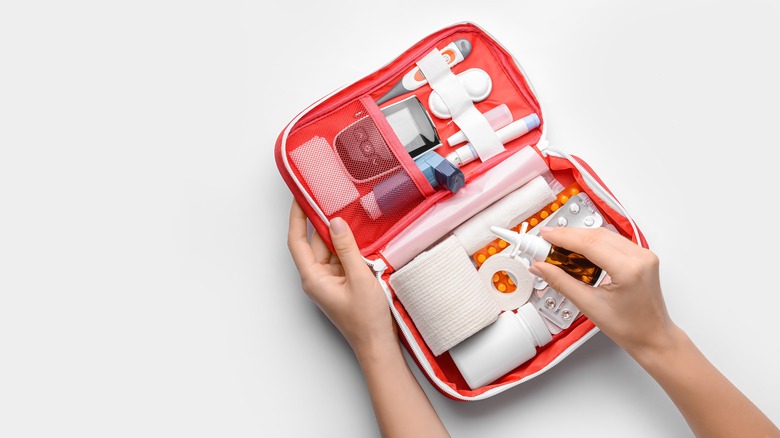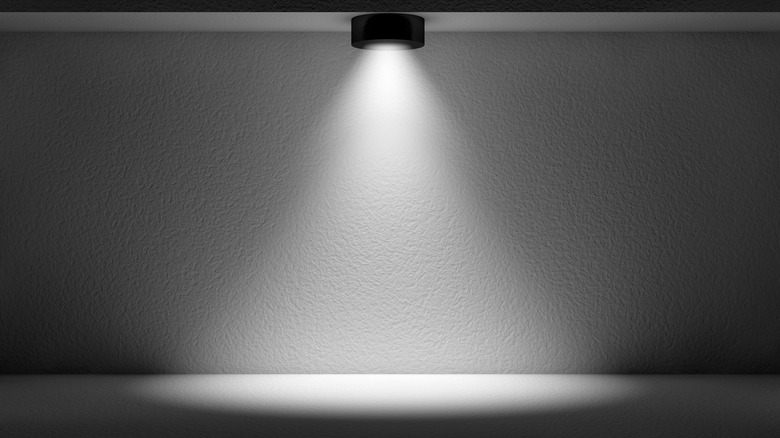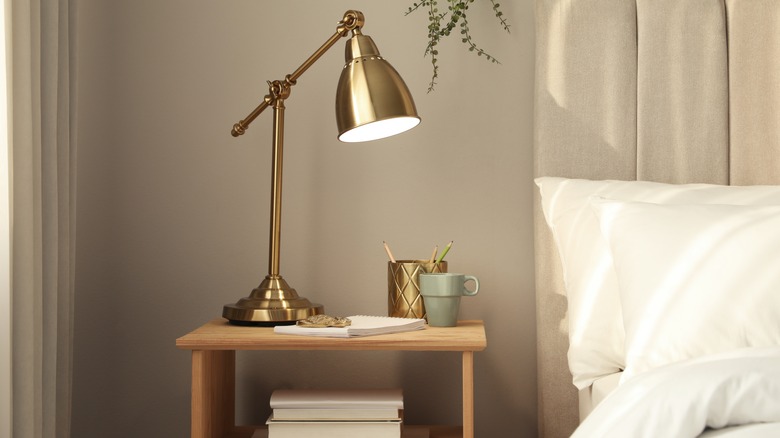5 Unexpected Uses For An Old Tool Box
Tool boxes (and to an extent their cousins, tackle boxes) tend to be a fairly commonplace in the average garage. There are a lot of shapes and sizes out there to choose from, supporting a wide variety of item storage uses from small around-the-house projects to full on car repair.
Nothing lasts forever, though, and tool boxes aren't immune to the need for replacement, and not solely from breaking or other forms of degradation, either. Maybe your storage needs have outgrown what you currently have. Maybe you don't have a need for any of the contents anymore but the box is still in good shape. Or maybe you just like the look of a newer model.
Regardless of the reasons, there's no need to throw away a perfectly good (or even somewhat rough looking) tool box. Because even if it doesn't cut it for holding your tools anymore, there are lots of other things you can use it for. Some of these possibilities can be found below, with suggestions based on a combination of personal experience, professional DIY inspiration, or regular old imagination.
Alternative storage solutions
Despite the rather specific name, tool boxes can be used to store and organize other items. You don't even have to make any adjustments to the box's interior if you don't want to. Though you may still want to clean it out first.
If the tool box has any sectioned off trays or other kinds of dividers, it could make an ideal organizer for all sorts of small objects. Jewelry is a fairly obvious option for a repurposed tool box, especially one with built-in trays or drawers. An old tool box can also hide knitting or sewing implements (or yarn, thread, etc) when they aren't in use. Someone who collects toys could use one to file away miscellaneous accessories that would otherwise clutter up a display. Tool boxes can also be a good place to keep extra batteries — just make sure you keep your battery storage box in a dry, roughly room temperature spot.
Tool boxes that don't have any dividers or shelves (basically a box with a hinged lid) can also be repurposed to hold objects you don't necessarily need to organize, but do want to keep in one location. It can also make for a decent (if somewhat small) toy box for kids to tuck their playtime leftovers into before bed — or before company comes over. The open container can be used for makeup storage as well if you remove the lid (to avoid bending brush bristles).
Kitchen helpers
A kitchen usually has its fair share of storage solutions with cabinets, cupboards, and drawers, but don't underestimate the usefulness of countertop options. Knife racks certainly have their place, but so can a repurposed tool box.
Depending on the size of the tool box, you could use it to organize silverware — or if you have multiple sets, use it to both organize one and keep it a little more separate from the others to avoid grabbing the wrong kind of utensil. With the addition of a divider or two, an otherwise empty (i.e. no shelves) tool box can also work as a storage solution for larger utensils like ladles, wire whisks, meat tenderizers, and so on.
Larger tool boxes can become a kitchen centerpiece with a little bit of planning and preparation. With some drawers pulled out and the top left open, you'd have a fairly tidy hot chocolate bar (with space for extra trimmings). By the same token, you could skip the hot chocolate and instead set up a miniature home bar. All you'd need is some liquor, glasses, and possibly a bartending kit. And while a big enough tool box could potentially be used to store all of these things (either for hot chocolate or alcohol), it's also fine to make it a temporary staging area that gets re-repurposed after the party is over.
Portable supplies
Smaller tool boxes can make for ideal travel-sized kits for a variety of materials or supplies. It all depends on how you use them.
Built-in dividers and trays are a good way to separate out smaller components, with larger supplies sitting at the bottom. It's great for storing all manner of paints and brushes — from an assortment of acrylics or oils for more traditional fire arts painting, to lacquers or enamels for use in model or miniature detailing. The same goes for crafting or scrapbooking gear like scissors, glue, tape (regular or washi), crafting paints, markers, hole punchers, etc. Or turn it into a sewing kit with various needles and threads, keeping it nearby in case anything needs stitching.
You can even create your own portable medical kit (though these are regularly sold in stores in a number of assortments). A bottle of disinfectant, bandages, medical tape, gause, maybe some tongue depressors to act as makeshift finger splits, and you've got yourself a handy travel-sized box full of what you need to handle various scrapes and bruises. Though nothing substitutes proper medical treatment, so definitely see a doctor or call paramedics for serious injuries.
A little redecoration
If you don't mind a little bit of DIY, an old toolbox can also be converted into one of several decorative options. And depending on what your plans are, it could be as simple as a coat of paint.
An empty tool box with no trays or dividers can be filled with dirt and placed outside to act as a planter for decorative flowers of a small garden. Or you can get a little fancier with it and paint up the outside (be sure to use a primer and paint meant for exteriors to resist weather damage), then drill a few holes in the bottom to allow excess moisture in the soil to drain.
To add a bit of extra flair to your workspace, you can also use that old tool box as a thematic light fixture or speaker box. This will require a fair bit more work, though, as you'll need to work out where the wall studs are and place mounting screws. Cut out the bottom (or any side of the box, really, it's up to you) to ensure light or sound can pass through, maybe add a piece of plastic to diffuse the light or some fabric to better hide the speakers and you should be good to go.
Furnishing furniture
For something with longer legs (literally), there's also the "turn it into furniture" route. Though attaching legs — in wood or metal — to the bottom of a tool box will require a little extra work. This is particularly true if the top of the lid has an attached handle, rather than being flat.
This may not work super well when using anything as big as an average sized shoe box, but something as simple as bolting a quartet of two foot long struts onto the bottom can create a small end table with some added internal storage options. Make those supports a bit taller — maybe three feet or so — and you have the makings of a night stand, or possibly a small table to keep near the front door for things like decorative plants or key storage. This could work particularly well if the tool box being used has front-facing drawers, since you can remove some of them to leave an opening for things like gloves or sunglasses but still use one or two remaining drawers for keys and the like.
Larger tool boxes have a larger surface area along the top, which means they have the potential to act as even larger table-style replacements. Keep it lower to the ground for a small coffee table or low seat.
